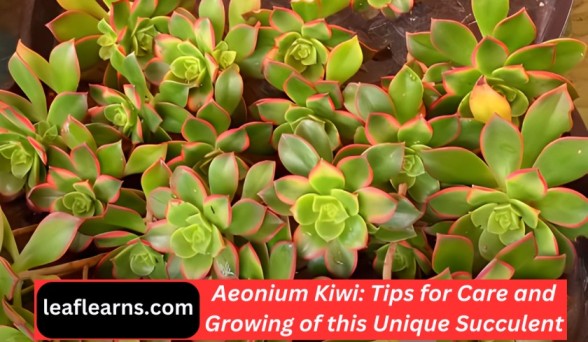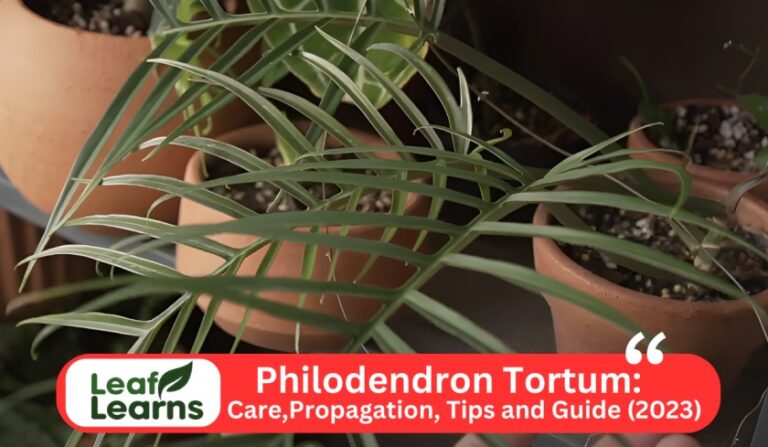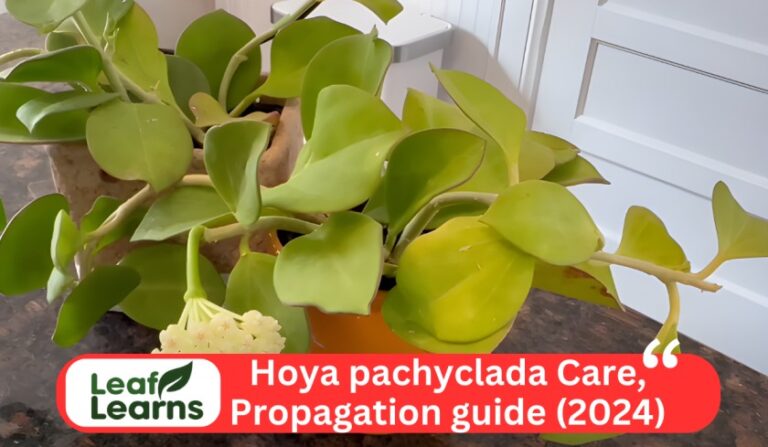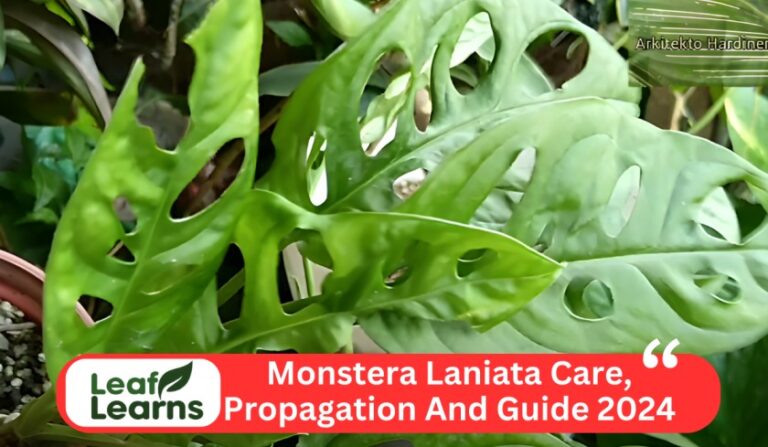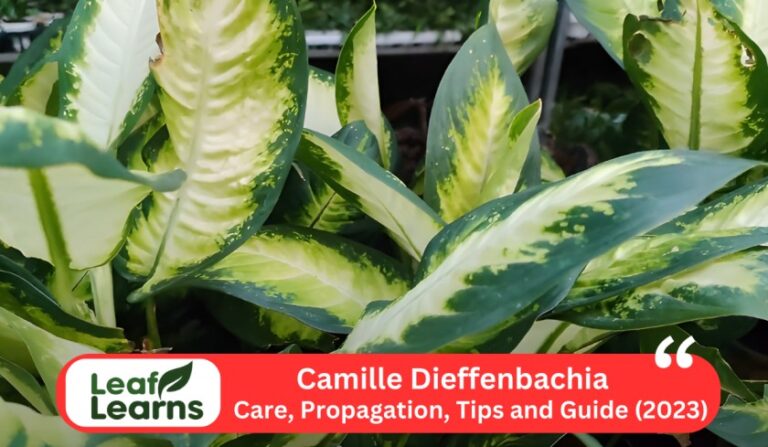Dischidia ruscifolia variegata (Variegated Million Hearts – Leaflearns (2024)
Variegated Million Hearts is an unusual succulent plant commonly known as Dischidia ruscifolia variegata. It is a native species to the Philippines belonging to the Apocynaceae family. The plant is named for the small, heart-shaped leaves which are cream or white variegated. The leaves are spirally placed on the stems and hence produce a tendency in the plant to cascade downward.
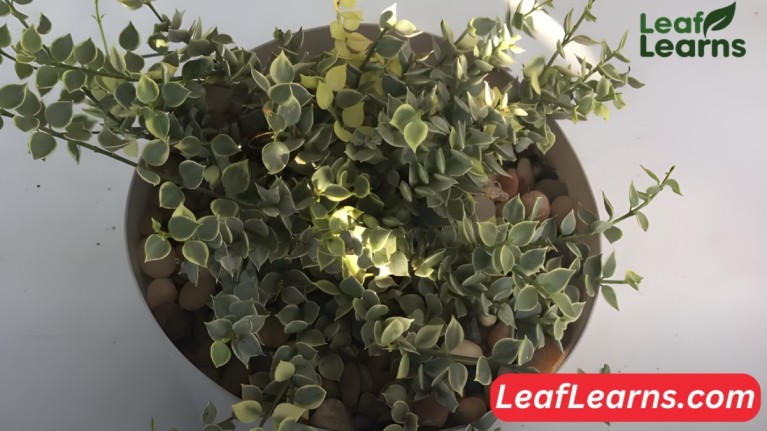
Dischidia ruscifolia variegata is not notably demanding. It loves bright indirect light and should be watered only when the soil is dry to the touch. The plant is tolerant to many temperatures and humidity levels. But the plant should be kept from cold drafts and direct sun.
It then has a variety called Dischidia ruscifolia-variegata which grows slowly but may finally stretch several feet long. The plant can be cultivated in hanging baskets or pots. It is also suitable for terrariums.
| Common Name | Dischidia ruscifolia variegata |
| Scientific Name | Dischidia ruscifolia variegata million hearts |
| Family | Apocynaceae |
| Origin | Southeast Asia |
| Plant Type | Epiphytic vine |
| Size | Up to 1 meter in length |
| Lifespan | Perennial |
| Flower | Small, white flowers occasionally |
| Light | Bright, indirect light |
| Water | Moderate, allow soil to dry slightly between waterings |
| Soil | Well-draining, aerated mix |
| Temperature | 65-80°F (18-27°C) |
| Humidity | High humidity preferred |
| USDA Zone | 10-12 |
| Fertilizer | Diluted, balanced fertilizer monthly during growing season |
| Propagation | Stem cuttings, water propagation |
| Pruning | Trim to control growth and maintain shape |
| Toxicity | Non-toxic |
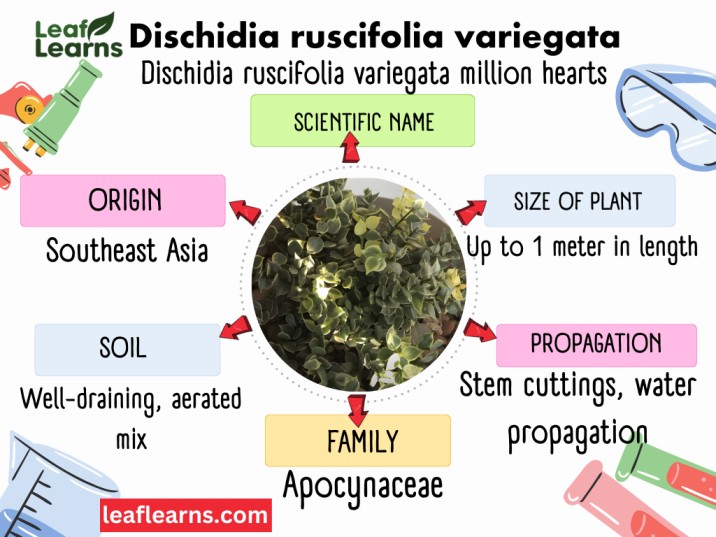
Contents
- 1 Dischidia ruscifolia variegata Care
- 2 Dischidia ruscifolia variegata Propagation
- 3 Pruning the Variegated Million Hearts
- 4 Repotting your Variegated Gem
- 5 Growth
- 6 Size
- 7 Dischidia ruscifolia variegata Flowers
- 8 Toxicity
- 9 Cultivating and Caring for Dischidia Varieties: Understanding Needs and Propagation Techniques
- 10 Ensuring Healthy Growth: Proper Plant Care Practices for Dischidia Species
- 11 FAQs
- 11.1 How do you care for Dischidia variegated?
- 11.2 Is Dischidia ruscifolia a succulent?
- 11.3 Is Dischidia ruscifolia a Hoya?
- 11.4 How do you propagate Dischidia ruscifolia variegata?
- 11.5 How do you grow Dischidia ruscifolia?
- 11.6 Why are my Dischidia ruscifolia variegata leaves turning yellow?
- 11.7 How often should I repot my ‘Variegated Million Hearts’?
- 11.8 Is Dischidia ruscifolia variegata toxic to pets?
Dischidia ruscifolia variegata Care
Light Requirement
Spring & Fall: Bright, indirect light is ideal. Filtered sunlight coming through south- or west-facing windows also works well.
Summer: To shield your plants from the afternoon scorching sun, go for covered east or north windows.
Winter: Get closer to a light scure so that the brightness is sustained, but not close to drafts.
Temperature Requirement
Year-round: Aim for 65-80°F (18-27°C). Slightly and avoids extremes below 50F degrees (10 degrees C) delineated and the temperature over 90 degrees F (32 degrees C).
Summer: Allow sufficient ventilation to avoid overheating.
Winter: Seek shelter away from draughts and draughty windows.
Humidity Requirement
Spring & Fall: A moderate humidity level of 40%-50% is sufficient. Occasional misting can help.
Summer: Humidify to 50-60% via misting, with humidity trays, or pebble trays on the bottom that are filled w/ water.
Winter: Mist less as the humidity naturally increases with heating. Do not keep it near radiators or heaters.
Water Requirements
The variegata Dischidia ruscifolia, fondly referred to as the heart-leaved plant, requires a soak-and-dry technique in watering. Here’s a seasonal breakdown to keep your plant happy:
Summer: In the warmer months the thirsty plants can require more frequent drinks. Water at the surface of the ground as a finger probe if a dry happens, approximately every 7-10 days. Boost the rate if your house is rendered hotter or the plant is exposed to direct sunlight.
Winter: Further to the reduction period of growth, waterings are also active less often. Soil should be tested every 2-3 weeks; water only if completely dry. Do not overwater, especially in cooler climates.
Spring & Fall: These seasons, in between, present a compromise. Water every 10- 1 Week, adjusting for how quickly the soil dries out and the growth patterns of the plant.

Soil, fertilizer, and potting Requirements
Summer
Soil: Use a mix that is well -draining, such as orchid bark, coco coir chips or lecca. Steer clear of keeping water around- regular potting soil that does not drain the water has many bacteria that may cause distress on one’s plants.
Fertilizer: Apply a partly diluted balanced fertilizer (20-20-20 or 9-9-9) every 3-4 weeks.
Potting: Select a pot that has holes for draining; it should be slightly bigger than the root ball.
Winter
Soil: Water infrequently, ensuring the mixture dries completely between watering.
Fertilizer: Put off fertilizing completely in winter.
Potting: No repotting is needed unless the pot hinders growth.
Spring
Soil: Resume with normal watering once the top inch of the soil dries.
Fertilizer: Every 2-3 weeks, apply diluted solution to fertilize.
Potting: If the plant is rootbound or tends to decline repotting can be used.
Fall
Soil: Lower watering frequency as temperatures drop.
Fertilizer: Reduce frequency of fertilizers, stopping before winter.
Potting: Repotting should better be done in autumn to reduce stress.
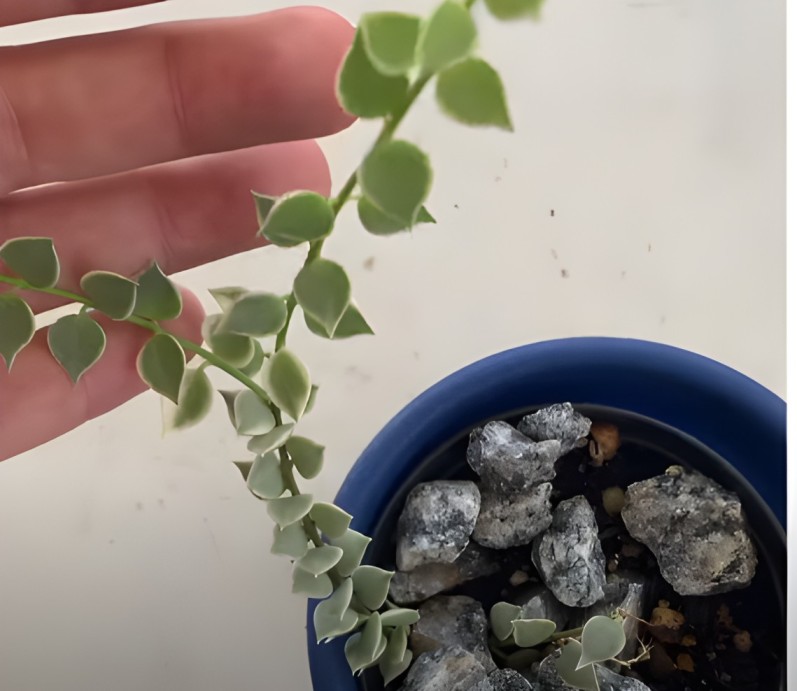
Dischidia ruscifolia variegata Propagation
There are multiple ways to propagate your beautiful Variegated Million Hearts plant, each with its own advantages and requirements. Here are three popular methods:
Stem Cuttings
This is the most common and straightforward method:
- Choose a healthy stem: Choose a healthy stem that has a 2-3 leaf set. Make sure it has a node (bum at leaf meeting point with stem) in between each leaf set.
- Make the cut: Work with a pair of pruners or scissors, sharp and sterilized, cutting right below a node. You want to shoot for a mutant length of about 3-4 inches.
- Remove lower leaves: Cut off the lower 1-2 leaves and allow the node to form roots.
- Let it dry: Leave the cutting out in the shade or in a cool well-ventilated place for 1-2 days to allow the cut end to callus thickly.
- Planting: Ready a well-draining pot that you fancy with a blend of orchid bark, perlite, or a succulent mix. You can also propagate using sphagnum moss.
- Moisten the medium: Moisten the selected medium slightly but not soak it.
- Plant the cutting: Insert the node end of the cut at least 1 in. deep in the medium. It can be held firmly if required using chopsticks or a skewer.
- Humidity and light: Position the pot in a warm spot that receives moderate light, not directly exposed to sunlight. Keep it moist by covering the pot with a plastic wrap/container of your choice with some ventilation holes on its sides.
- Watering: Mist the substrate lightly every few days to keep it just moist but not damp. Do not water excessively as this leads to the rotting of roots.
- Rooting and growth: Be patient! Root take is anywhere from 2- six weeks. As the roots establish this can be slowly removed and the plant is acclimated to slightly lower humidity.

Leaf Cuttings
This method takes longer but can be successful with healthy leaves:
- Choose a healthy leaf: Select a plump, mature leaf with a petiole (stalk).
- Cut the leaf: Carefully cut the leaf with a petiole attached, leaving a small section of the stem connected.
- Let it dry: Follow the same drying process as stem cuttings (1-2 days).
- Planting: Choose a shallow pot with drainage holes and well-draining medium like sphagnum moss or perlite mix.
- Prepare the leaf: Lay the leaf flat on the medium with the petiole end slightly buried. Alternatively, you can prop the leaf upright with the petiole in contact with the medium.
- Humidity and light: Maintain high humidity as in method 1. Provide bright, indirect light.
- Watering: Mist the medium regularly to keep it slightly moist but not wet.
- Rooting and growth: This method can take several weeks or even months for roots and new growth to appear. Be patient and provide consistent moisture and humidity.
Water Propagation
This method is quicker but requires more attention:
- Prepare a container: Put filtered water in a glass jar or a container with a transparent side.
- Place the cutting: Place the node end of the stem cutting (without leaves) into the water leaving no leaf in contact with the water.
- Location and light: Leave the container in a warm area with indirect lousy sunlight.
- Change water: Replace the water every 2-3 days to avoid water stagnation and supply it with fresh oxygen.
- Rooting and growth: Look for root growth at the node. As soon as roots have grown to about 1-2 inches in length, transplant the cutting to gritty soil as per method 1.
Pruning the Variegated Million Hearts
A little bit of pruning of Dischidia ruscifolia-variegata is also required. Cut t- snip, if the cascading stems get too long or uncontrolled. Above a leaf node, make a diagonal cut to stimulate re-growth.
Wear gloves for your skin as the sap can cause the irritation. Use cuttings for propagation!
Repotting your Variegated Gem
Repot your Million Hearts every 2-3 years or if potbound. Select a container that has holes at the bottom, but is larger than that. The succulent mix should be well-draining. Water infrequently after repotting to encourage root establishment.
Growth
Dischidia ruscifolia variegata is a careful expander, gradually sensing its power not to unshroud its careless appeal, its frail and delicate wild current.
It is also the usual speed based on the treatment that it has gotten. In optimum conditions, you can approximate 1-2 inches of growth in a month.
This delicate beauty is incredibly infinitesimal and that is why you should take your time at all costs.
Size
Despite its small scale, this plant has a strong visual impression. It is wonderful for hanging baskets or trailing displays since it can grow up to 18 inches tall and has cascading branches that extend up to 3 feet.
Dischidia ruscifolia variegata Flowers
Dischidia ruscifolia variegata can reward you with little, white, or cream blooms tucked close to the leaf axils, even if the foliage takes center stage.
Blooming, however, is not always assured and frequently needs certain stimuli, such as strong light and little temperature changes.
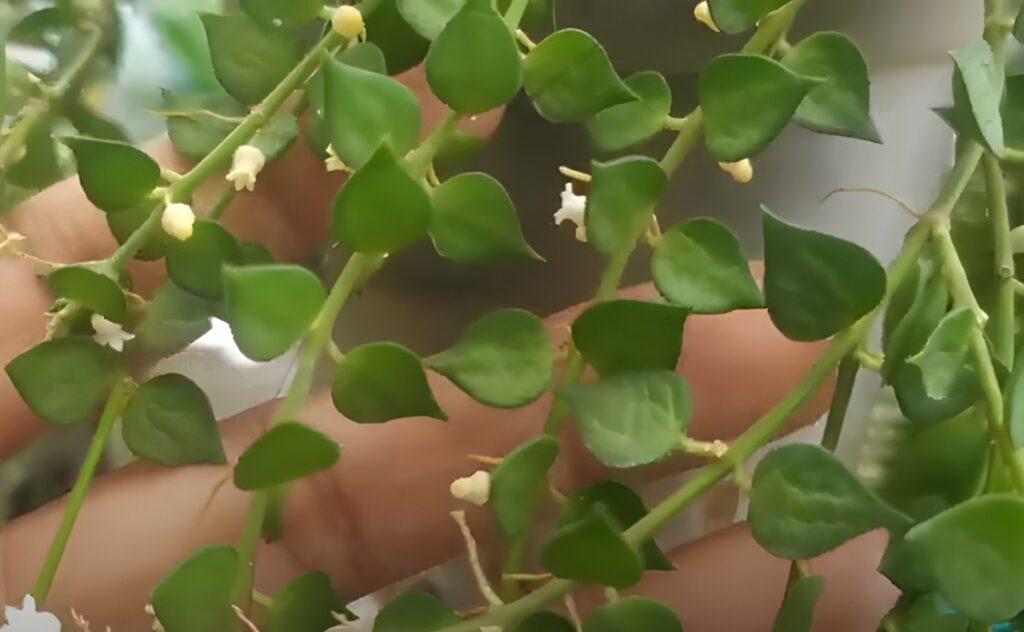
Toxicity
Dischidia Ruscifolia Variegata is toxic to Humans, Cats and Dogs. It’s sap can irritate skin when it comes into touch with it. Skin irritation, burning, or redness may result from touching the leaves or blossoms. Any portion of the plant that is consumed might cause diarrhea, nausea, and vomiting. Obtain medical assistance if consumed.
Like with people, cats may experience discomfort from the sap if it irritates their skin or eyes. More severe symptoms, such as vomiting, diarrhea, and stomach discomfort, might occur after ingestion. If symptoms appear, keep the plant out of reach and see a veterinarian.
Dogs are more vulnerable to the toxicity of the herb. While eating plant parts might result in vomiting, diarrhea, tremors, and even seizures, coming into touch with sap can irritate the skin. If your dog eats the plant, it is imperative that they receive immediate medical attention.
Cultivating and Caring for Dischidia Varieties: Understanding Needs and Propagation Techniques
When it comes to cultivating and caring for Dischidia varieties, particularly the captivating Dischidia ruscifolia-variegata, it’s essential to understand their specific needs and propagation techniques.
From purchasing Dischidia plants (Dischidia kaufen) to nurturing them through their growth stages, proper care is paramount for their well-being. This entails providing adequate light, moisture, and nutrients while also being mindful of their susceptibility to overwatering.
Propagation methods, such as water propagation or stem cuttings, offer opportunities to expand your Dischidia collection and share the beauty of variegated foliage with fellow enthusiasts.
With a combination of patience and attention to detail, the intricate leaves of Dischidia-ruscifolia variegata (Dischidia ruscifolia-variegata bilder) can flourish, adding a touch of natural elegance to any indoor space.
Ensuring Healthy Growth: Proper Plant Care Practices for Dischidia Species
To ensure the health and vitality of Dischidia plants, adhering to proper plant care practices is crucial. From understanding Dischidia care tips to mastering propagation techniques like propagating Dischidia ovata and Dischidia nummularia, cultivating these plants requires dedication and knowledge.
Providing the right environment, including well-draining soil and appropriate watering schedules, is key to fostering healthy growth. Additionally, regular maintenance tasks such as repotting, pruning, and fertilizing contribute to the overall well-being of Dischidia species.
Whether you’re a seasoned plant enthusiast or a novice gardener, learning how to care for Dischidia plants offers a rewarding experience and the opportunity to witness the beauty of nature thrive in your home.
FAQs
How do you care for Dischidia variegated?
Dischidia grows best in well-draining soil and bright, indirect light. When the soil is totally dry, water it, and spritz it periodically to maintain humidity. Don’t overwater!
Is Dischidia ruscifolia a succulent?
Yes, because of its succulent nature and ability to store water in its leaves, Dischidia ruscifolia is regarded as such.
Is Dischidia ruscifolia a Hoya?
No, while both belong to the Apocynaceae family, they are separate genera.
How do you propagate Dischidia ruscifolia variegata?
The simplest approach is to use stem cuttings. Cut off a healthy node, soak it in rooting hormone, then put it in water or damp soil.
How do you grow Dischidia ruscifolia?
Grow in a well-drained container or hanging basket. When it is dry, provide a lot of indirect light and thoroughly water. To help with humidity, spray lightly.
Why are my Dischidia ruscifolia variegata leaves turning yellow?
By far the most likely cause is overwatering. Examine the roots for decay and modify your watering schedule. Nutrient or light deficiency may also be factor.
How often should I repot my ‘Variegated Million Hearts’?
Repot every 2-3 years to a slightly larger pot with fresh, well-draining soil.
Is Dischidia ruscifolia variegata toxic to pets?
Yes, if swallowed by dogs, the sap can irritate their skin and create stomach problems. If you suspect ingestion, keep the plant out of reach and contact a veterinarian.

